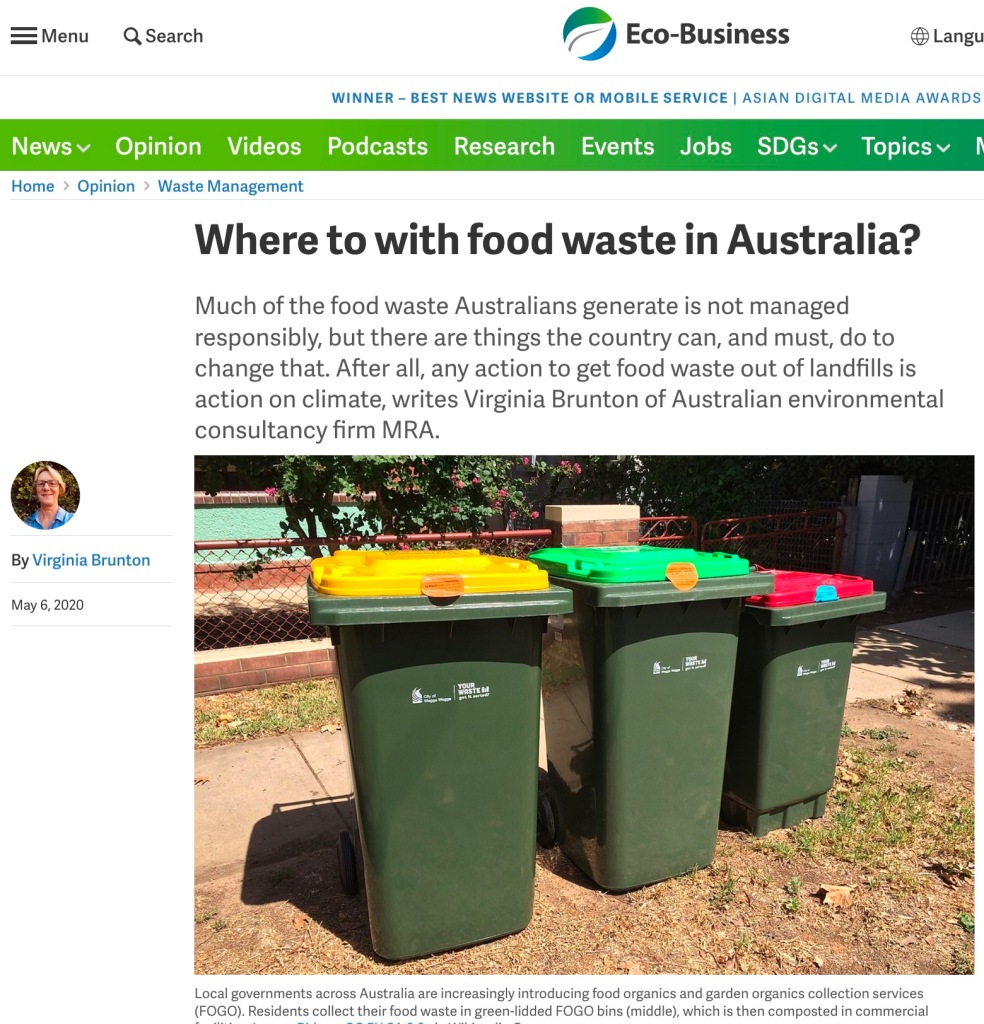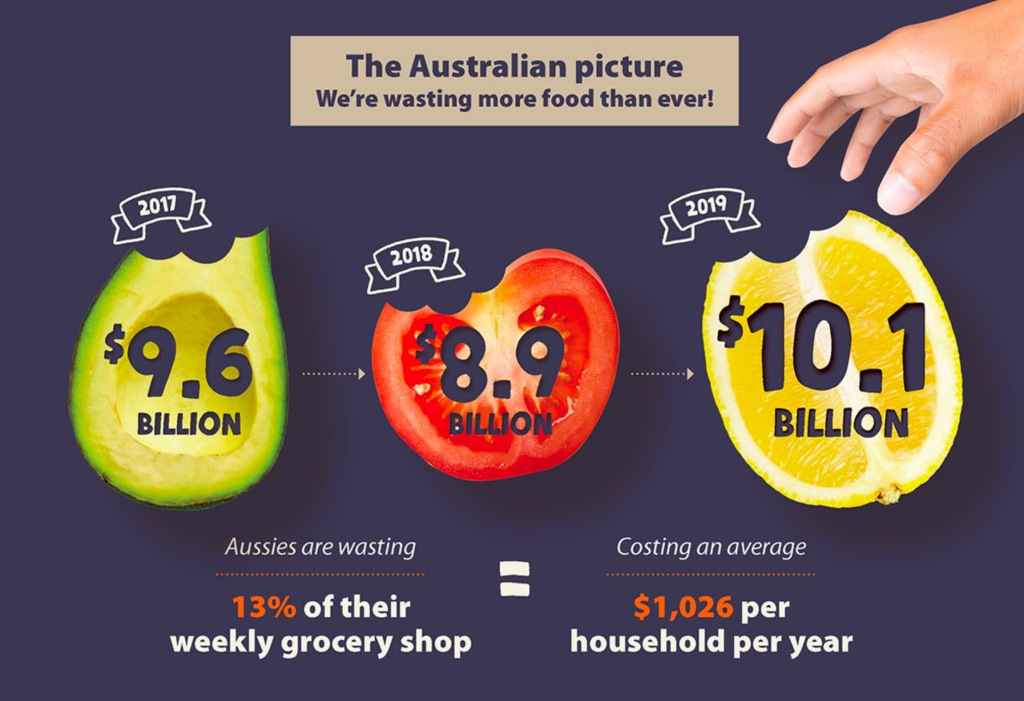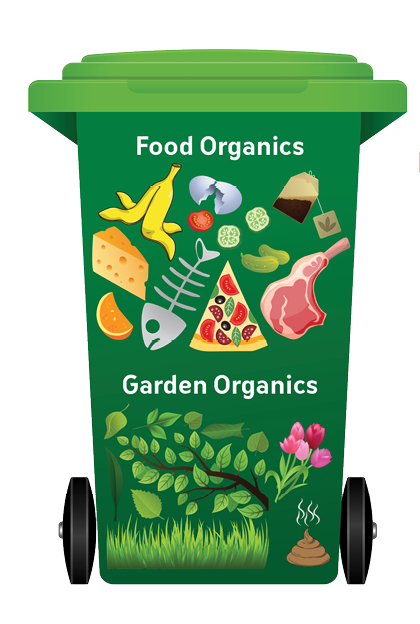Where to with food waste
By Virginia Brunton, MRA Consulting Group
There is undoubtedly a connection between this catastrophic fire season and increasing global warming leading to climate change. And we might feel powerless as individuals to do anything about it. But one thing we can do as individuals, households, local councils, state governments and federal governments is address food waste in landfill. Why? How does this relate to climate change?
As the Food and Agriculture Organisation says “If global food waste was a country, it would be the third largest emitter of greenhouse gases in the world, behind the U.S. and China”[1]. On average Australians throw out 20% of the food they buy and are generating 7.6 million tonnes of carbon dioxide equivalents (CO2-e) just from our food waste.[2]
So, getting food waste out of landfill will impact our emissions and its within our reach.
| The climate change impacts of food waste |
|---|
| Globally, food waste generates about 8% of anthropogenic GHG emissions – about the same as road transport emissions. |
| On average Australians throw out 20% of the food they buy. Every tonne of food waste in landfill generates just over a tonne of CO2-e. |
| Food waste in landfill rots, it doesn’t compost. It generates methane, a gas 25 times more potent as a greenhouse gas, than CO2. |
| Australians are generating about 8 million tonnes of CO2-e just from our food waste. |
| If that wasted food (2.3million tonnes or 373kg/household) was composted, fed to animals, put in a worm farm or eaten, we would reduce the equivalent emissions for an average household of 63 days energy use or the same emissions as driving a car for 6 full tanks of petrol. |
OK let’s home compost
When I mention to people that I work in compost they invariably say; ‘Oh I love compost’, followed by; ‘Why do you think my compost heap stinks/has flies/does nothing?’. Home composting is an art and a science, it requires know how, dedication and a mix of materials. The word ‘compost’ is derived from the French compote meaning combination or mixture. Composts are mixtures. Get the mixing ratio wrong and the materials do not compost.
Home composting is obviously something you can do yourself. Many local councils in the past have assisted residents with home composting courses, free or discounted bins and instructional literature.
Albury City Council for example ran a program in 2011 and 2012 promoting home composting as a means of reduce waste to landfill. The program consisted of free compost bins, workshops and supporting literature and email guidance and trouble shooting. The program was initially really successful with over 1900 households participating. But steadily interest and participation declined.
Each household on average generates about 6 kg of food waste per week. Depending on the type of food that’s about 4 buckets or 40 litres worth. This needs to be combined with the right amount of dryer material, typically this is garden prunings and lawn clippings. To create the optimal composting conditions the mix has to be both moist and open and airy. Food waste alone will turn into a rotten mass and leaves and twigs will remain uncomposted for years. However, with these materials combined in the right proportion (3 kg of garden waste for every 1 kg of food waste) you can get a good composting process underway. For an average household, in a week you’d need about 18 kg of garden waste to mix with the food waste. However, an average household only generates about 5 kg of garden waste a week and in summer the majority of that is lawn clippings. (The problem with lawn clipping is that no matter how much you add to food waste you will never reach the correct balance, they are just too wet and too high in nitrogen.)
But let’s assume you had 18 kg of garden waste to add to your 6 kg of food waste. This volume would fill a standard 220 litre compost bin each and every week. This material needs to be composted for about 12 weeks, so that means 13 bins are needed on rotation. And so we begin to see why so many people have trouble home composting, and why so many households get enthusiastic about composting, start, then fail to keep it up. It’s not the lack of knowledge or understanding or intention, it’s a lack of the appropriate resources to make it work.
Those enthusiastic home composters often have to compromise and use whatever materials they have. The mix inevitably has more food than the amount of garden waste can absorb and to make it work, they religiously turn it every 2 or 3 days, keep adding garden material as it comes to hand and work hard to make it happen. But sadly, for most would-be composters, the results are, all too often, a wet, smelly fly-ridden mass. It’s a rare household then that can make home composting work. It’s an ideal but is it rarely an effective and efficient food waste recovery tool.
Worm farms are also offered as a solution to home generated food waste. Assuming ideal conditions worms can eat half their body weight in food per day. The 2kg of worms in the hardware store kits can eat about 1kg per day. Hint: put them in a much bigger worm farm if you can, with a large surface area to spread out the food scraps. But they are a bit fussy. They don’t like it too wet, or too dry, or too hot, or too cold. Nor do they like onions, cooked food, citrus, salty or oily food, tomatoes, potatoes, meat or dairy – so just the uncooked or rotten vegetable scraps which is only about 1/3 of the food waste from a kitchen. One great advantage is that they fit into a balcony so they’re great for those in units or without a yard. So, whilst worm farms are fun, and I have one, they are not really practical for dealing with all the food from your kitchen.
Where to next then for your food waste?
Most local government areas across metropolitan and regional Australia have garden organics collection in place. These organics are composted in specifically designed facilities and produce a very high-quality composted product for agricultural, horticultural and urban markets. If food waste needs garden organics to be properly composted should not these two be combined?
What can local governments do?
Increasingly local governments across Australia are introducing FOGO! This allows residents to collect their food waste (all food waste) in a kitchen caddy and then place it in the green-lidded bin which becomes a FOGO (Food organics and garden organics) bin. The organics are then collected and composted in commercial facilities specifically designed to compost with minimal odour and great environmental benefits. The resulting compost goes onto farms or into the urban landscape as potting mix or landscape soils.
More than seventy Australian Councils now provide FOGO services. The main advantage for Councils is that it reduces the overall waste disposal bill, works to achieve waste diversion targets and massively reduces greenhouse gas emissions by avoiding putting the organics in landfill. Diverting food waste into commercial composting costs less than landfilling. It’s a very straight forward win:win.
However, not every Council does it. In Sydney for example only one council, Penrith, has a FOGO service that covers the entire community. In South Australia by comparison all Adelaide metropolitan local government areas have FOGO, in Melbourne five metropolitan councils have impl
Tweet
If you are lucky enough to be in a FOGO Council area, you will have experienced or seen some community engagement; ads on TV, newsletters, pop-up FOGO info booths, bin information in the letter box, perhaps even a door knock. Rolling out FOGO requires investment in education, and not just once, repeatedly, before during and after roll-out.
In Albury, the results of a well thought out education campaign is a 0.3% contamination rate in the FOGO bin. People are careful about what goes into their bins.
What can the State Governments do?
State Governments have constitutional control over waste. They make and enact the legislation and create an economic environment conducive to resource recovery.
In NSW for example, there is a waste levy of $143.70/tonne for waste disposed to a landfill. As a result, to bury one tonne of waste in the greater Sydney area costs around $330/tonne and therefore most recycling costs less than landfilling. This is the main economic driver for resource recovery in NSW. The less waste a generator directs to landfill the less the waste disposal costs on their bottom line.
Using market-based instruments like waste levies, Governments can incentivise recovery options over landfill disposal. There is a high level of inconsistency in levies across Australia from $0/t in Tas, NT and ACT to $110 in SA and $143.70 in NSW. Vic, QLD and WA are in the middle.
There are other mechanisms such as landfill bans that State Governments could also use. Victoria has done this with the e-waste landfill ban.
Bans on organics to landfill, or mandated limits on organics in landfills, would create a dramatic shift in organics recovery (and preserve valuable landfill space in the process). It would provide the incentive needed by Councils to introduce FOGO. It would need to be phased in over a number of years however, to allow the processors time to build the composting facilities.
A move such as this would also capture commercial food waste; from restaurants, food manufacturers, supermarkets and wholesalers.
What can the Federal Government do?
The key instrument for waste management at the Federal level is the National Waste Policy and the National Food Waste Strategy. The next iterations of these documents should set mandatory targets for the recycling of food and avoidance of landfill.
That would have the effect of aligning all State and Territory waste planning toward FOGO composting, Anaerobic Digestion and other non-landfill solutions for waste.
Such policy directions are normal and well-practiced in European countries but our politicians have been reluctant to impose policies on State and local Governments, and through them onto you and I.
But we need this sort of leadership. Doing nothing means we will continue to landfill precious food waste rather than giving it back to farmers as compost.
What can you do?
If you are in a FOGO Council put all your food waste into your kitchen caddy and into your green bin. All of it. The preparation scraps yes, but also include the rotten vegetables in the bottom of the crisper, those un-eaten salad greens, the chicken carcass, the lamb bone, the fat from the pan, scrapings off the plates. All of this combined with the garden organics makes great compost and saves methane generation in landfill.
If, however, you are not in a FOGO Council, you can lobby your local Council to introduce FOGO and make a real difference. Until then, look for community compositing initiatives, try a worm farm or give home composting a go.
Any action to get food waste out of landfill is action on climate.
Make your own green way.
[1] http://www.fao.org/3/a-bb144e.pdf
[2] https://www.environment.gov.au/system/files/resources/4683826b-5d9f-4e65-9344-a900060915b1/files/national-food-waste-strategy.pdf
As always, we welcome your feedback on this, or any other topic on ‘The Tipping Point’.
This article has been published by the following media outlets:









